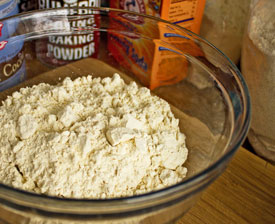
Homemade Gluten Free Flour Mixes
Replace wheat or other gluten flours in bread or dessert recipes

I make gf flour mixes in big batches and store in the fridge or freezer. They work with all my baking, beat any gf mixes I've found in stores, plus it's way cheaper to make your own.
I buy supplies onlne; at Indian groceries; in bulk at natural food stores - looking for best prices & free shipping. I buy a 2 - 3 month supply at once, and make up my mixes as needed.
I'd LOVE it if I could find all the ingredients in BIG bags, and Bob's Red Mill had user friendly packaging. I may just have to get an electric grain mill!
Total prep time: 20 minutes
6 cups gf flour mix
Nutrition Data Per 1 cup GF bread mix: 485 cal, 5g fat, fat cal 45, 97g carb, 391mg sodium, 4g fiber, 0g sugars, 16g protein, low cholesterol, good source potassium, thiamin, iron. Estimated glycemic load: 15
Nutrition Data Per 1 cup AP GF mix: 478 cal, 4g fat, fat cal 33, 101g carb, 1mg sodium, 7g fiber, 0g sugars, 15g protein, good source potassium, thiamin, iron. Estimated glycemic load: 15
GF Flour Mix Recipe Index
Gum Replacer GF Bread Flour Mix GF Sourdough Bread Flour Mix All Purpose Gluten Free Baking Flour MixGum Replacer
This recipe is my Americanized approximate version of The Gluten Free Doctor's 'pixie dust'. Jean Layton's recipe is metric, which is more accurate, but I don't have a kitchen scale - very bad of me, I know.
Use this magical 'pixie dust' mixture to replace xanthan gum or guar gum in gluten free baking. Substitute 1 Tbsp gum repacer for 1 tsp gum in any recipe. I sometimes do a partial replacement.
Use black or white chia seeds, brown or golden flax seeds. The darker seeds are easier to find.
Ingredients:
- 2 parts flax seeds (brown or golden)
- 1 part chia seeds (black or white)
- 1 part psyllum husks
Finely grind the ingredients in a coffee or spice grinder. A blender or mini food processor will also work, but may not grind as fine, and will tend to make butter instead of powder.
GF Whole Grain Bread Flour Mix
Use for flatbread, regular yeast bread (not sourdough), whole grain muffins or pancakes. This mix includes salt and xanthan gum, makes an elastic and kneadable dough, and flexible tortillas or other flatbreads.
Switch millet or oat flour for sorghum flour; substitute part teff or amaranth flour; use corn meal or corn flour instead of oat flour to make cornbread or corn tortillas.
I usually double this recipe to make 12 cups, enough for 4 batches of flatbread or tortilla dough
Ingredients:
- 2 cups millet flour
- 1 1/2 cups oat flour (if you must use certified gf oat flour and can't find any, grind gf rolled oats in a spice grinder or blender)
- 2/3 cup tapioca flour
- 2/3 cup arrowroot OR organic corn starch (non-gmo)OR potato starch
- 2/3 cup garbanzo bean flour (besan) or garfava flour (not as easy to find)
- 1/2 cup sweet rice flour
- 2 tsp xanthan gum (Bobs's Red Mill sells a corn free x. gum)
- 2 tsp salt
GF Sourdough Bread Flour Mix
Makes 8 cups flour mix, enough for 3 - 4 loaves of gf sourdough sandwich bread.
This mix is meant for sourdough bread, which is batter based, not kneaded. It has a higher percentage of starch to make the bread lighter and easier to rise.
Part A is whole grain gf flours, Part B is gf starches, xanthan gum and salt
Use Part A (the whole grain mix) to feed your sourdough starter.
I have omitted gum replacer, corn starch, xanthan gum and salt from the starch mix. It's better to add those as needed for individual recipes.
Note when using commercial gf flour mixes: Some of those additional ingredients may be included in the mix, so either you won't need to include them in your recipe, or you can reduce the amounts.
Store Part A and Part B separately. When baking bread, use the two parts in the proportions that you need for your recipe. E.G., in my gf sourdough bread, I use 3/4 cup whole grain mix + 1 3/4 cups starch mix. With the flours in the starter, that approximates a 40/60 whole grain/white flour bread mix.
Ingredients:
Part A: Whole Grain Mix - 5 1/4 cups
- 2 cups millet flour
- 1 1/2 cups oat or sorghum flour
- 1 cup brown rice flour
- 3/4 cup garbanzo bean or fava bean flour or a mixture
Part B: Starch Mix - 5 1/4 cups
- 2 cups potato starch
- 2 cups tapioca starch
- 1 1/4 cups sweet or glutinous rice flour
All Purpose Gluten Free Baking Flour Mix
Adapted from Ricki Heller's ap mix in her Naturally Sweet and Gluten Free Dessert cookbook. This mix can be substituted 1:1 for all purpose wheat flour, as it has a similar starch|protein ratio, which makes it easy to make your favorite dessert recipes gluten free.
Ingredients:
- 3 cups millet flour or sorghum flour or combination
- 1 cup tapioca starch
- 1 cup potato starch
- 1/2 cup sweet rice flour
- 1/4 cup garbanzo or fava bean flour
- 1/4 cup organic corn starch or arrowroot starch
Directions:
- Measure all ingredients carefully
- Mix well, using a whisk or food processor
- Store in an air tight container in the fridge or freezer to use as needed
Recipe Tips:
Exact measurements are important, to maintain a good wet dry balance in your recipes. However, I've found that the mixes get fluffed up and expand in volume right after they're mixed, but condense again in storage. So if you're mixing, then using right away, you may need to overmeasure the flour in your recipe by 10 - 20%, or pack down the flour.
I like oat flour for bread mixes because it's soft and sticky, which helps make an elastic dough. But it's hard to find certified gluten free, which is important if you have CD. Sorghum flour is easy to find, and a reasonable substitute for oat flour. Or you can grind certified gf rolled oats in a spice grinder or blender to make flour.
No matter what gf mix I'm using, I find that I need to increase the liquid by about 20%, or reduce the amount of flour in most recipes, so keep your eye on the consistency and adjust as needed when adapting standard recipes.
Most rice flours are gritty, especially brown rice flours. We found one brand of superfine brown rice flour, but it's not widely available. You can buy it at Authentic Foods Gluten Free Supermarket. It's expensive and the shipping is high, but it might be worth it, for the mild, sweet flavor of rice flour - if not for the bread mix recipe, then maybe for the AP mix. We found a super fine white rice flour in the local supermarket in the Asian foods section - Mochiko brand sweet rice flour.
We've also found gf flours in Indian grocery stores: millet, amaranth, and rice flour for example - they're good, and much cheaper.
Asian groceries are a great source of super fine white rice and sweet rice flour, plus tapioca starch, arrowroot starch and potato starch.
Good online sources for gf flours and starches: Amazon, Vitacost, Swanson's Health Products.
Your comments & questions help improve our recipes, so don't be shy! Contact Us







